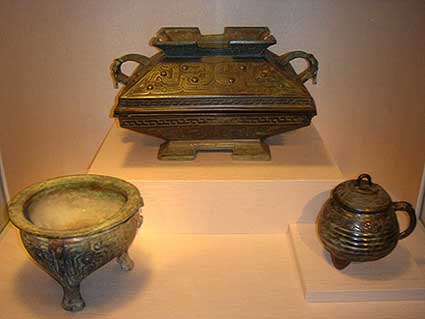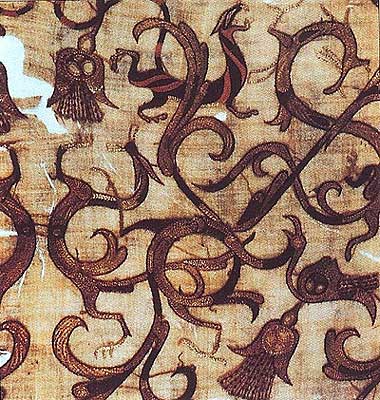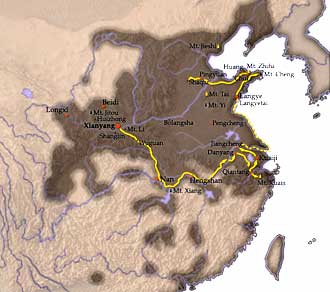

Our greatest glory is not in never falling, but in getting up every time we do. Confucius
The Zhou dynasty took over power from the Shang ca. 1122 BC, and moved the center of power to the south and west, into the Wei River Valley near the modern city of Xi'an. Click here to see a map of the extent of Zhou control; the early stages of the Great Wall, were built under the Zhou dynasty.
Chinese society remained highly stratified under the Zhou with a king or emperor at the top, along with a royal court. The increasingly large geographic area nominally under the Zhou rulers was divided into partially independent provinces, with their own rulers. Rebellions were common, and particularly in the later half of the dynasty, capitals shifted as a result. The overall trend was to larger and larger cities, mostly walled. The Zhou city of G'a-to probably had some 270,000 people prior to 600 BC. The later Zhou rulers placed a greater emphasis on taxation of peasants, rather than conscripted labor.
The Zhou dynasty is also the time of the philosopher Confucius (ca 551-479 BC), whose teachings on order, deference, family ties and the right way to live a life were to influence Chinese culture to the present day. A quote from Confucius leads this lesson; for the source and many more of his wise sayings, click here. [My personal favorite, as an archaeologist, is "Study the past if you would define the future."] Lao-Tse (604-531 BC), the founder of Taoism, also is associated with the Zhou dynasty.
The required link is on the burial of a high class noble,the Count of Yu, in early Zhou times; be sure to read the brief article, and click on the links to see the bronze and jade objects. Below are other examples of Zhou bronzes, as well as an early fragment of silk.

Ceremonial bronze food containers, and a bronze drink container [Wikimedia Commons]

Fragment of Embroidered Silk, ca. 400 BC [Public Domain]
By 600 BC iron metallurgy had started in China, and agricultural tools at least were made of iron. Irrigation works were constructed, and wet-rice irrigation in at least the southern part of the Zhou territory became common. Ox-drawn (or water buffalo-drawn) plows also increased the productivity of agriculture. After 475 BC, the eastern area entered what is often called the Warring States Period, which ended only with the re-establishment of strong centralized rule under the Qin Dynasty in 221 BC.
The major, and almost the only emperor of the Qin Dynasty, Shih Huang Ti, (or Qin Shihuang) was reportedly both ambitious and ruthless. Shih Huang Ti built much of the Great Wall of China, primarily by extending and connecting walls built by earlier states. [Click here for a virtual tour of a section of the Great Wall.] According to many, the purpose of the Great Wall was to prevent the peasants, suffering under heavy taxes and conscription for labor, from escaping the emperor's reach. The 1500 miles of wall, wide enough for six horses to ride abreast, took over 700,000 conscripts to build. He also built roads and canals, and was reported to have a standing army of a half a million men.
Shih Huang Ti saw Confucian philosophy as a threat to his own authority, burned books associated with this school, and buried alive the Confucian scholars who refused to accept this change. In its place Shih Huang Ti put a political philosophy called legalism, which in many respects justified the government's totalitarian activities.

Map of Area unified under the Qin (capital Xianyang), with route of the travels of Shih Huang Ti [from Wikipedia images]
As soon as he became emperor, Shih Huang Ti conscripted another 700,000 men and began to build his tomb. At one time the tomb was 150 feet high, and was part of a walled complex that covered 500 acres. The tomb itself has not been excavated, though it was reported to be filled with models of palaces, waterways, and other structures, and to contain an outer coffin of molten copper. All kinds of fine artifacts, including precious stones, were reportedly buried with the emperor. Guarding the east side of the emperor's tomb are some 6,000-7,000 terra cotta soldiers, along with terra cotta horses and wooden chariots. (Terra cotta is a baked clay ceramic, orange-brown in color.) This terra cotta army is slightly larger than life size. Each soldier has an individual face (suggesting they were from real-life models) and was once brightly painted. See below for one illustration; also click here for more photos (and even videos) and see your text, pp. 482-487. In addition to the horses and soldiers, artifacts of gold, bronze, jade, silk, linen, bamboo, and bone were found, along with pottery containers and iron agricultural implements.
When Shih Huang Ti died, his dynasty survived by only a few years. The unification of China did survive however, in the subsequent Han dynasty (206 BC-220 AD).

Some of the 7,000 soldiers of the Terra Cotta Army [Wikimedia Commons Public Domain Photo]